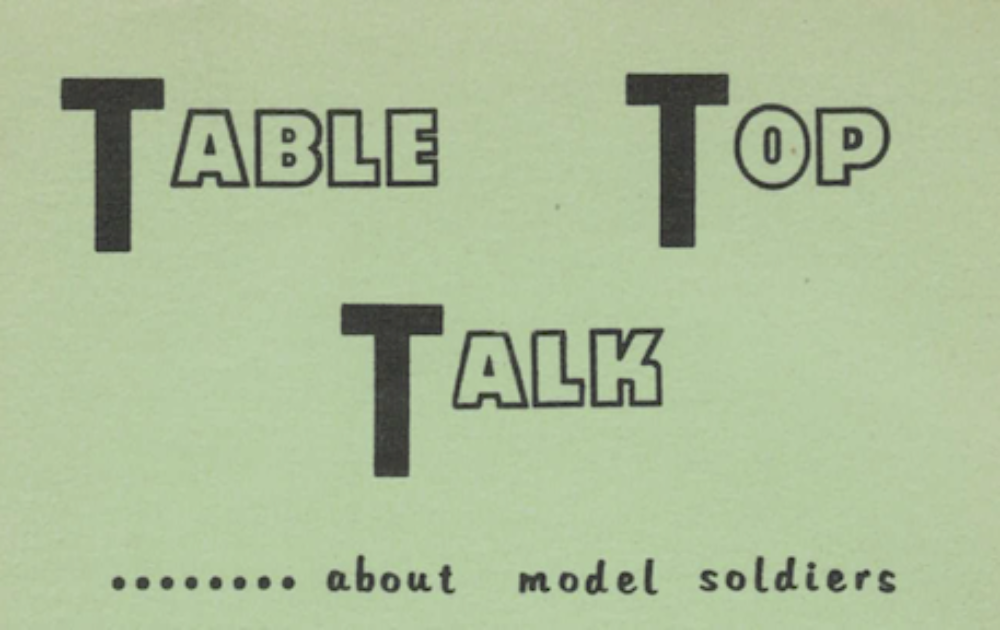Presented for your reading pleasure is another interesting look a how Joe played his war games…
LIMITED WAR GAMES
Table Top Talk, July 1963
by Joseph Morschauser
Like Le Grand Charlie (DeGaulle) most war gamers seem fascinated with a “grand design”. It is rarely enough to fight a good, small battle. There is nothing for it but massive campaigns, huge battles, ponderous maneuvers. This ca get mighty dull and so tiring that it can slowly kill the excitement a good war gamer should get out of his hobby. An occasional Waterloo is fun but too many Waterloos will drown the spirit of even the most avid, player.
If you have reached the stage of massivitis in war gaming might I suggest that you stop and consider limited war gaming. Some years back a lot of thinking people suddenly realized that all-out atomic war was hardly the answer to every nibble our enemies tried to reduce free world influence. Out of this came the concept of “limited war”, wars fought with a minimum of force, equipment and troops to gain limited ends. The same idea can be applied to war gaming. You need not always set up thousand-man battles to satisfy your ends. Limited war in miniature will often fill the bill.
A limited war in miniature is one with a minimum of soldiers whose commander has limited objectives. The object need not and should not, be the total destruction of the enemy, nor the complete occupation of enemy territory on the table. In limited war gaming certain limited objectives are set at the beginning of the game, and the game itself is limited to a certain number of turns. The winner of such a battle is the commander who gains greater percentage of success in achieving the limited objectives.
Possibly the best illustration of a limited war game is the small, modern offense/defense type of battle. The defensive side consists of perhaps 75 to 100 soldiers, including riflemen, machine guns, mortars, anti-tank rocket launchers and possibly a heavy anti-tank gun or two. Their objective is to hold a series of designated strong points along their front. To this end their commander entrenches them as he sees fit, keeping some elements in reserve. The exact area of each strong-point is marked on the table so there can be no arguments proper occupation during the battle.
The offensive side is detailed a somewhat larger force which consists of 100 to 150 soldiers; riflemen, sub-machine gunners, rocket launchers, satchel charge carriers. In addition their attack will be supported by several armored vehicles such as a tank and several armored cars. These vehicles should mount weapons with shorter range and lower, killing power than the heavy anti-tank guns of the defense. (I know many modem war gamers will scream at this, but we are seeking an enjoyable game, and if the attacker can out-range and out-power the defender he need only sit back and pot the defense to pieces; This hardly a “fun” game.)
The battle might be limited to eight turns with the, offense moving first from a line well back towards the edge of its table The objective of the offense is to capture or occupy and hold as many of the defenses strong-points as possible during the eight moves. The objective of the defense of course is to hold as many of these strong points as possible. (It is quite possible that a defense commander. might willingly give up several without a fight to begin with, and then try to retake them before the end of the eighth move.) At the end of the action each side receives a certain number of points for each strongpoint it holds. If there are soldiers of both forces in several strong-point areas, the points are broken up according to numbers and strength of each side.
What is being done in this type of limited war game is usually listed in modern war communiques as “improvement positions”. For example: “Our troops today on the western front improved their positions.” The Improvement in a campaign may go on for months without a Waterloo, each such being a miniature battle, a limited: battle. On the other hand the “improvement” may merely be the preparation for a major push. Still such limited battles can be fun on a war game table. They are easier on the nerves, back and temper. You can fight a whole series of them during a period when other; activities (non-war game activities like making a living!) may eat up a lot of your time. Then when you do have time and energy you can plunge into your Waterloo type massive battle and really get full kicks from it.
Limited war games in miniature can be played in any period of time, any era of history. The Romans had lots of limited actions, so did the British, the French in the early 1800’s. I have used modern period here because limited actions are so typical of modern times but that doesn’t mean the ancients fought only massive actions (The US army was engaged in, limited war with the Indians of the west for years and years.) You can “improve your positions” no matter what period of history you favor.
If massivitis and the Waterloo psychology has begun to afflict your war gaming (and it does to most) then it is time you tried the modern (?) concept of limited war, limited actions on your war game table. It is not a substitute for those glorious, sweeping panoramas of hundreds, thousands, of tiny troops crushing a foe to the last man. But it is a good carry-over for war games between the big ones, a carry-over which can give you a lot of fun and entertainment at a minimum of cost and exhaustion. Try limited actions in miniature for the maximum of fun from your hobby.
